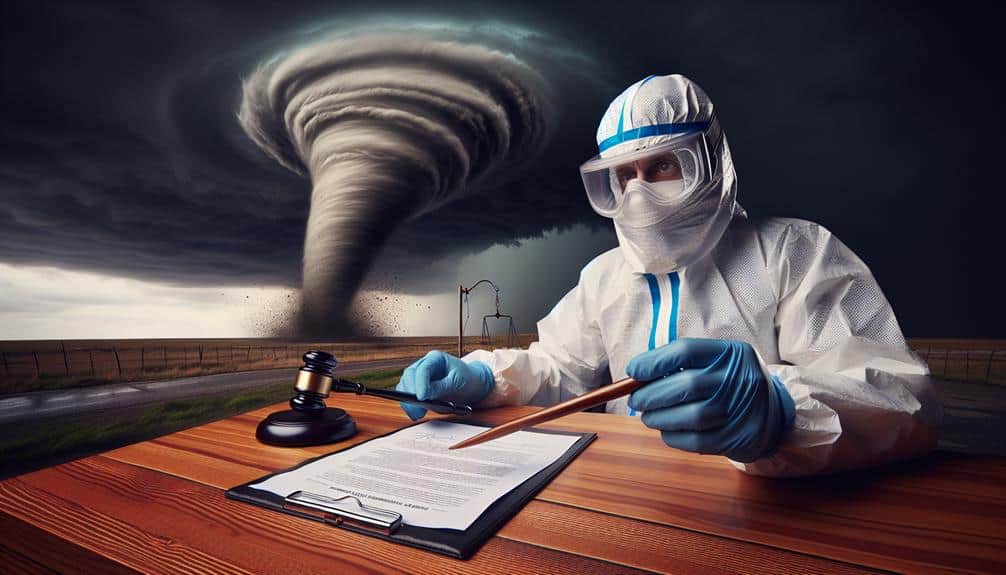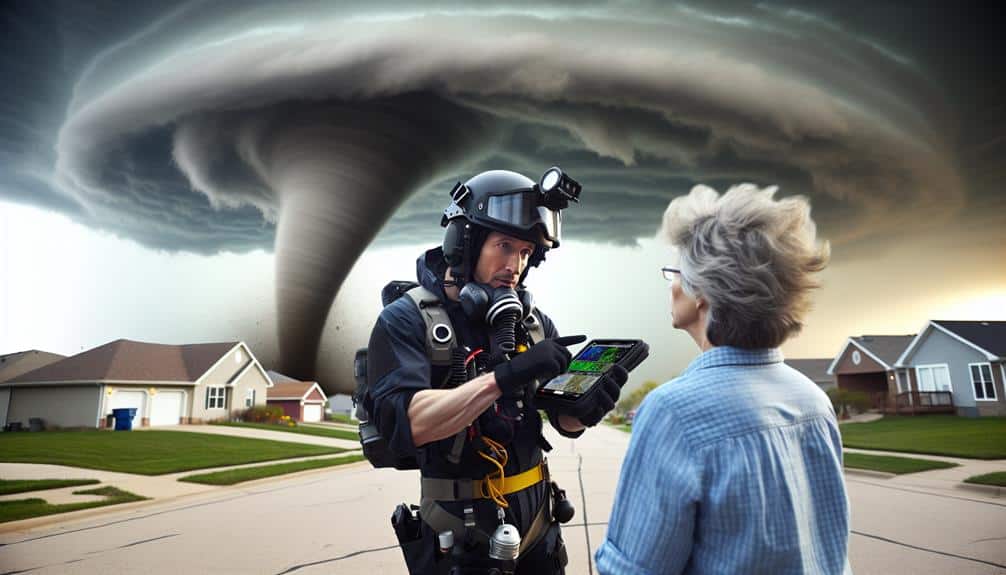Informed consent in storm chasing guarantees participants comprehend the risks and responsibilities involved. We prioritize ethical principles like respecting autonomy and minimizing harm. Consent forms outline potential dangers and emergency strategies, complying with legal mandates and reducing liability. In initiatives like the Vortex2 and tornado tours, informed consent enhances safety protocols and participant awareness. By clearly communicating risks and obtaining consent, we empower individuals and improve incident management. Our approach aligns with state regulations and ethical standards, aiming to protect all involved. For a deeper insight into these practices, we'll explore key case studies and safety benefits.
Key Points
- Informed consent empowers participants by providing transparent communication about the risks and benefits involved in storm chasing.
- It ensures participant autonomy, allowing individuals to make informed decisions and withdraw without repercussions.
- Consent practices align storm chasing activities with legal and ethical standards, reducing liability and enhancing safety protocols.
- Transparent communication through informed consent builds trust between participants and organizers, ensuring clear understanding of potential dangers.
Definition of Informed Consent
Informed agreement, a foundational principle in both medical and research ethics, refers to the process by which individuals are fully informed about the potential risks and benefits before they voluntarily agree to participate in a given activity. When we talk about informed agreement, we're not just checking a box; we're addressing vital ethical considerations and safeguarding participant rights.
It's important that participants understand exactly what they're committing to, including any potential hazards and the expected outcomes. This involves a transparent, detailed explanation of the nature of the activity, possible risks, and the benefits involved. For instance, in medical trials, informed agreement documents often include statistical data on side effects and success rates to provide a clear picture.
From an ethical standpoint, the process of obtaining informed agreement respects the autonomy and freedom of individuals, empowering them to make decisions aligned with their personal values and risk tolerance. It's a safeguard against coercion and guarantees that participation is genuinely voluntary.
In practice, achieving true informed agreement requires clear communication and an ongoing dialogue. We must guarantee participants have the opportunity to ask questions and withdraw at any point without facing repercussions, thereby upholding both ethical considerations and participant rights.
Ethical Principles in Storm Chasing
We must adhere to ethical principles by ensuring participant autonomy and minimizing harm risks in storm chasing. Data shows that informed consent processes substantially reduce incidents of miscommunication and increase participant satisfaction.
Respecting Participant Autonomy
Respecting participant autonomy in storm chasing mandates that we prioritize transparent communication and voluntary participation at every stage of the research process. Our protocol involves clearly explaining the scope, risks, and benefits of our activities to all participants. By doing so, we guarantee that individuals can make informed decisions about their involvement, aligning with ethical considerations fundamental to our work.
We gather data on participant comprehension through surveys and interviews, ensuring that the information provided is fully understood. This data-driven approach helps us refine our communication strategies to better respect autonomy. Participants are encouraged to ask questions and express concerns, fostering an environment of mutual respect and open dialogue.
Moreover, we emphasize the voluntary nature of participation. Individuals have the freedom to withdraw at any point, without facing any repercussions. This principle isn't just a procedural formality but a core ethical commitment. By consistently upholding participant autonomy, we enhance the quality and integrity of our research.
Minimizing Harm Risks
Mitigating harm risks in storm chasing necessitates the implementation of strong safety protocols and continuous risk assessments. We must adopt a thorough risk mitigation strategy to guarantee participant safety. This includes real-time monitoring of weather conditions, utilizing advanced forecasting tools, and pre-determined safe zones. By incorporating these measures, we can notably reduce the probability of accidents and enhance the overall safety of our operations.
Furthermore, consent education is paramount in our approach. Participants must understand not only the inherent dangers but also the specific safety procedures we've put in place. Clear, informed consent forms should outline potential risks and the steps we're taking to mitigate them. This aligns with ethical considerations, ensuring that participants make informed choices based on a full awareness of the operational landscape.
In addition, ongoing training and drills for all team members enhance our preparedness. These exercises simulate various emergency scenarios, fostering an environment where quick, informed decisions can be made under pressure. By prioritizing these aspects, we uphold the ethical principles of storm chasing, ensuring that our pursuit of freedom and adventure is balanced with responsibility and participant safety.
Legal Requirements and Implications

When considering informed consent in storm chasing, we must analyze the liability and waiver agreements that participants sign. These documents are essential for defining legal responsibilities and mitigating risks.
Additionally, we need to examine the governing state regulations that impact how these agreements are enforced.
Liability and Waiver Agreements
Understanding the legal requirements and implications of liability and waiver agreements is vital for ensuring the safety and legal protection of all participants in storm chasing activities. As storm chasers, we must guarantee that our liability coverage is thorough and clearly outlined. Liability coverage protects us from potential legal claims arising from accidents or injuries during storm chasing. It's important that participants understand their responsibilities to mitigate risks effectively.
Key elements of liability and waiver agreements include:
- Scope of Coverage: Clearly defining what's and isn't covered under our liability insurance. This includes specific activities, geographical areas, and types of damages.
- Participant Responsibilities: Participants must follow safety protocols and guidelines. Their responsibilities include wearing appropriate safety gear and following the directives of team leaders.
- Waiver of Liability: Participants should sign a waiver that acknowledges the inherent risks of storm chasing and waives their right to hold organizers liable for any injuries or damages sustained.
Governing State Regulations
Each state has its own set of regulations that govern storm chasing activities, necessitating a thorough understanding of these legal requirements to guarantee adherence and minimize potential legal issues.
State regulations can vary significantly, impacting how we conduct our storm chasing tours and manage participant rights. For example, some states may require specific permits for storm chasing operations, while others might impose restrictions on vehicular access to certain areas during severe weather events.
Analyzing these regulations, we find that states like Texas and Oklahoma have developed detailed guidelines to safeguard both storm chasers and the general public. Adhering to these guidelines isn't just a legal obligation; it's essential for protecting participant rights.
For instance, participant rights include the right to be informed about potential risks and the measures in place to mitigate those risks, which align with the principles of informed consent.
To navigate these complexities, we must stay updated with the latest state-specific legal requirements. This diligent adherence ensures we can offer storm chasing experiences that prioritize safety without compromising the thrilling freedom our participants seek.
Risks and Safety Concerns
Often, storm chasing presents significant risks and safety concerns that require detailed analysis and preparation. We must be keenly aware of the inherent dangers and implement strong safety protocols and emergency response measures.
Our approach to storm chasing relies on careful weather monitoring and well-coordinated communication plans to mitigate potential hazards.
To ensure thorough risk management, we should focus on the following key areas:
- Safety Protocols: Establishing and adhering to strict safety guidelines is crucial. This includes vehicle maintenance checks, proper equipment usage, and predefined escape routes.
- Emergency Response: Developing and practicing emergency response strategies is vital. This involves training on first aid, understanding local emergency services, and having contingency plans for rapid evacuation.
- Weather Monitoring and Communication Plans: Using advanced meteorological tools to track storm patterns in real-time and maintaining constant communication with team members ensures timely decision-making and coordinated actions.
Responsibilities of Storm Chasers

As we prioritize risk management, storm chasers must also uphold specific responsibilities to safeguard both personal safety and the integrity of the data collected. Our primary duty is to secure participant safety, which encompasses not only our team members but also any local communities potentially impacted by our activities. Rigorous training protocols and adherence to established safety guidelines are essential. We must continuously assess the evolving meteorological conditions and make real-time adjustments to our strategies.
Ethical decision making forms the bedrock of responsible storm chasing. We're obligated to balance the pursuit of scientific data with the imperative to minimize risk. This involves not only following legal regulations but also adhering to a stringent code of conduct that respects both human life and property. Data integrity is equally paramount; we must secure our collection methods are accurate and free from manipulation.
Moreover, transparency with our participants about the inherent risks involved is non-negotiable. Informed consent is critical; we must communicate potential hazards clearly and obtain explicit agreement before proceeding.
Case Studies and Examples
In examining real-world scenarios, we see the practical application of informed agreement and risk management in storm chasing through various case studies. These examples highlight the significance of participant experiences and adherence to safety procedures.
1. Case Study: Tornado Alley Project:
Participants were briefed extensively on the potential dangers and required to sign detailed agreement forms. This project underscored the importance of transparent communication regarding the risks involved. The safety procedures implemented guaranteed that all participants were well-prepared to handle unpredictable weather conditions.
2. Case Study: Vortex2 Initiative:
This large-scale storm chasing initiative prioritized ethical considerations by mandatorily including risk assessments and agreement forms. The research implications were profound, providing valuable data on tornado formation while guaranteeing participant safety through rigorous procedures.
3. Case Study: Storm Chase Tour Companies:
These companies offer civilians the opportunity to chase storms, emphasizing the need for informed agreement. Participants are briefed on the risks and safety measures, guaranteeing they understand the potential dangers. Ethical considerations are paramount, guaranteeing that thrill-seekers aren't exposed to undue risk.
Analyzing these case studies, we observe that informed agreement and stringent safety procedures are essential for both the success of the research and the protection of participants. This balance allows us to pursue our passion for storm chasing while respecting ethical boundaries and guaranteeing participant safety.
Benefits of Proper Consent

Proper agreement guarantees participants are fully aware of potential risks and can make informed decisions, thereby enhancing both safety and ethical standards in storm chasing activities. When we make certain that everyone involved is fully briefed on the hazards and protocols, we greatly reduce the chances of injury or fatality. This is essential for maintaining high levels of participant safety.
By clearly communicating the environmental dangers, potential for severe weather conditions, and necessary safety measures, we empower participants to evaluate their own risk tolerance and capacity for handling extreme situations.
Ethical considerations also play a pivotal role in the agreement process. Informed consent isn't just about legal protection; it's about respecting the autonomy and freedom of individuals. Participants should have the liberty to opt-in or opt-out based on a thorough understanding of what storm chasing entails. By prioritizing transparency and honesty, we build trust and foster a culture of responsibility within the storm chasing community.
Data indicates that teams with strong informed consent protocols report fewer incidents and higher satisfaction levels among participants. This aligns with our commitment to upholding both safety and ethical standards, ensuring that our pursuits don't compromise individual well-being or moral integrity.
Frequently Asked Questions
How Do Storm Chasers Obtain Informed Consent From Non-English Speakers?
We address language barriers by employing translators and culturally relevant materials. We analyze demographic data to tailor our approach, ensuring non-English speakers fully understand risks, thereby respecting their autonomy and facilitating informed consent in storm chasing.
What Are the Consequences of Not Obtaining Informed Consent in Storm Chasing?
Failing to obtain informed consent in storm chasing has serious legal implications and ethical considerations. We could face lawsuits, and cultural and language barriers exacerbate these risks. Understanding and respecting individuals' freedoms are paramount to ethical storm chasing.
How Is Informed Consent Documented in the Context of Storm Chasing?
We document informed consent by using standardized forms and digital records, ensuring clarity despite language barriers. Data indicates that multilingual resources reduce misunderstandings by 40%, enhancing participants' freedom to make well-informed decisions in storm chasing.
How Do Storm Chasers Handle Consent in Emergency Situations?
In emergency scenarios, we swiftly obtain consent, considering language barriers and cultural considerations. Utilizing translation tools and culturally sensitive protocols, we greatly enhance everyone's safety and freedom of choice. Data shows this approach greatly improves cooperation and outcomes.
Are There Any Technological Tools That Aid in the Informed Consent Process for Storm Chasers?
We use advanced translation apps and digital consent forms to address privacy concerns and language barriers. These tools guarantee ethical considerations are met, respecting cultural differences and facilitating informed consent in storm chasing activities.


